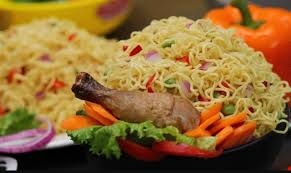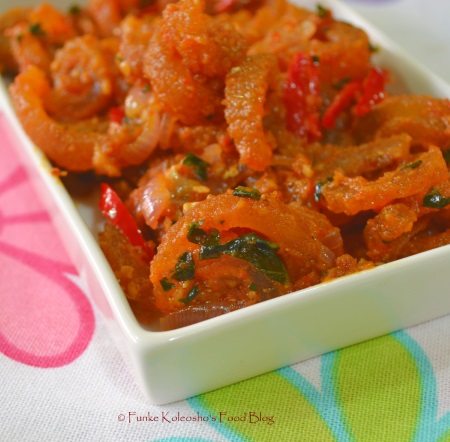Jaykay
Business Person : I'm An Honest Person
Wants to meet Business Partners
Articles
404
Followers
24
profile/4914IMG_20200909_155545.jpg
Jaykay

Cow Skin (pomo) To Eat Or Not To Eat
~8.3 mins read
Copied
profile/4914IMG_20200909_155545.jpg
Jaykay

Top 5 Ways To Make Indomie Noodles
~5.3 mins read
Top 5 Ways To Make Indomie Noodles
Indomie noodles is the most popular Nigerian pasta brand. Just like any other noodles, it is easy to make and does not require any extra ingredients.
Even though not necessary, vegetables and other ingredients spice up noodles when added. It boost the flavour and makes it more nutritious.
Knowing how to prepare noodles in many ways is exciting because you get to enjoy the same food with different taste, flavour and nutrients.
That's why am going to show you 5 interesting ways to make any noodles delicious and irresistible at the same time.
1. The Fried Indomie Noodles
The ingredients for fried indomie:
• 3 packs of Indomie instant noodles
• 5 tablespoons of vegetable oil
• 1 medium sized onion
• 2 plum tomatoes
• 2 large eggs (or 3 small eggs)
• 3 baby carrots (or 2 medium sized carrots)
• 2 red peppers
• 1 handful of green beans
Directions
• Bring 400 ml of water to a boil. When it starts boiling, add the noodles and leave to cook for 3 minutes on medium heat.
• Cut all the vegetables into small pieces and set aside. When the noodles are cooked, pour into a sieve to drain the water.
• Take a pan and pour some vegetable oil into it, about 5 tablespoons. Place it on the stove, on medium heat.
• When the oil is hot enough, add all the vegetables. Season them with salt, pepper and the follow-come seasonings. Fry the vegetables and stir them together from time to time.
• While the vegetables are cooking, take a bowl and crack the eggs into it. Add some salt and pepper then beat vigorously to mix well.
• Take another pan and place it on the stove on medium heat. When the pan is hot, pour some oil into it and let it heat up as well.
• When the oil is hot enough, pour the eggs into the pan. Fry till it is thick, flip it over and fry the egg until it is ready. Turn off the stove, cover the pan to keep the egg warm.
• When the vegetables are soft (especially ty carrots), add the cooked noodles to the mix. Stir everything together until the vegetables and noodles are well combined.
• Reduce the heat to low and cook the vegetable-noodle mix until the noodles are fluffy. That's it, your delicious plate of Noodles is ready.
• Take a plate and place the noodles on it. Place the scrambled eggs next to it and enjoy!
2. The Frank Indomie Noodles
The ingredients for frank indomie noodles:
• 3-4 big franks (beef sausages)
• 3 packs of Indomie instant noodles
• Cheese
• 3 springs onions
• Vegetable oil
Directions
• Boil the noodles, sieve and place in a bowl. Add the follow-come seasonings to it and mix well. Slice the franks and spring onions. Grate the cheese and set all aside.
• Take a saucepan and place it on the stove on medium heat. Pour some oil into the pan and let it heat up. When the oil is hot, add the sausages and let them fry.
• Stir from time to time, to make sure that there are frying evenly. Add the boiled noodles to the sausages in the saucepan.
• Turn the heat to low and add the spring onions. Stir from time to time. Make sure that the sausages are well fried, and the noodles are fluffy.
• When the noodles and sausages are ready, place them on a plate. Cover it with grated cheese (make sure to do it while the noodles are still hot). Enjoy!
3. Indomie Noodle Soup
Ingredients
• 2 small indomie noodles
• 2 large Eggs
• Cabbage as desired
• 1 green pepper
• 1 big bulb Onion
• Curry leaves (optional)
• 2 small carrots
• 2 Red pepper
Directions
• Slice the cabbage, onions, carrots, red and green peppers and set aside. Put a medium sized pot on heat, add some water and bring to a boil.
• When it starts boiling, add the eggs to the boiling water then indomie seasoning with some chopped onion.
• Now, add the indomie noodles, stir and cover to simmer for 3 minutes on medium heat. Add the chopped vegetables, mix very well and cook for another 2 minutes.
• Indomie noodles is ready to be served hot. Enjoy!
4. One Bowl Indomie Noodles
Ingredients
• 2 sachets indomie noodles
• 2 Eggs
• 1 big bulb Onions
• 3 fresh tomatoes
• fresh pepper to taste
• Salt to taste
• Vegetable oil
Directions
• Pieces the indomie into a bowl and pour hot water to it. Allow for about five minutes for the noodles to get soft.
• Set your frying pan on fire and heat up some vegetable oil. Add the sliced tomatoes, onions, fresh pepper and a pinch of salt to taste then fry for about five minutes.
• Sieve the indomie noodles (remove water) then add the follow-come ingredients while still in the bowl, at this point the noodles will be both soft and hot.
• Break the two eggs into the same bowl containing the noodles and stir together, then transfer to the frying pan containing the fried tomatoes, onions and peppers.
• Stir together until all ingredients are well combined. Then fry for about five minutes and you just made a yummy plate of indomie noodles. Enjoy!
[img][/img][img][/img]
5. Leafy Vegetable Indomie Noodles
Ingredients
• 1 big Indomie noodles
• 2 big Eggs
• 2 fresh Pepper
• 3 big tomatoes
• 1 big bulb Onions
• 2 cups Green/Ugu or Curry leaves
• Salt to taste
• Vegetable oil
Directions
• Slice the peppers, tomatoes and onions into small pieces. Wash and chop the leafy vegetables you prefer and set them aside.
• Break the egg into a plate, add a pinch of salt to it and beat thoroughly until well mixed.
• Parboil the noodles and sieve. Place the boiled noodles in a bowl and add the follow-come seasoning to it. Mix properly.
• Heat up some vegetable oil in a pan and add the onions, peppers, tomatoes and salt to taste. Fry for about 5 minutes on medium heat.
• Now, add the leafy vegetables to the frying ingredients and stir together. Next, add the eggs and stir to mix with the vegetables.
• Fry for 2 minutes then add the indomie noodles and mix together until well combined. Leave to simmer for 3 more minutes and that's it.
• It is ready. Serve hot with your favourite soft drink. Enjoy!
Advertisement

Link socials
Matches
Loading...

